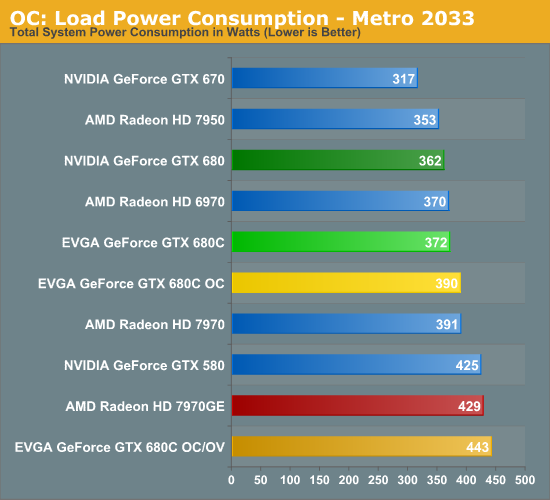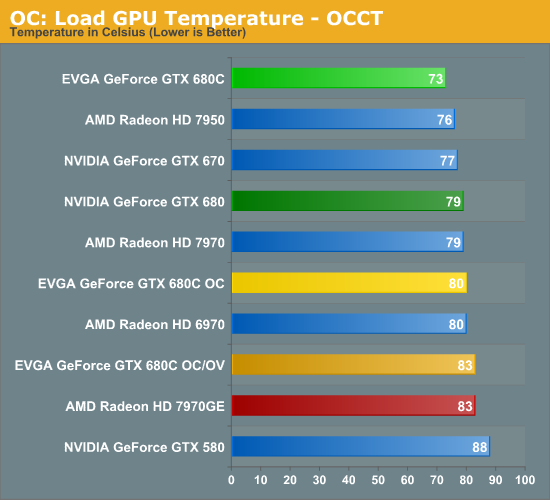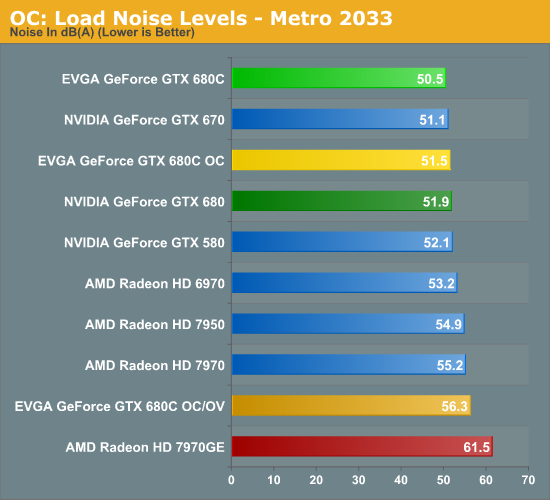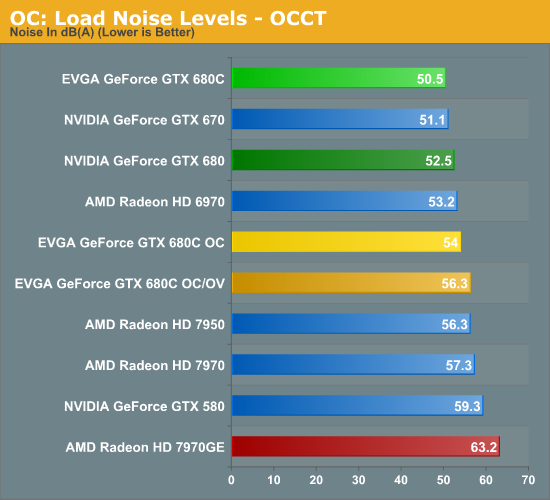EVGA GeForce GTX 680 Classified Review: Pushing GTX 680 To Its Peak
by Ryan Smith on July 20, 2012 12:00 PM ESTOverclocked: Power, Temperature, & Noise
So far our look at the stock performance of the GTX 680 Classified has been more obligatory than critical. The GTX 680 Classified is first and foremost an overclocking card, and while EVGA ships it with a decent factory overclock it’s the end-user overclock that is going to make the GTX 680 Classified stand apart from the crowd.
So how did the GTX 680 Classified fare? As always, we’re going to break our results down into two categories. We’ve overclocked our sample both with and without overvolting it, to get an idea of just how much more headroom is left in the GK104 GPU at stock, and how much more headroom is unlocked through overvolting.
| EVGA GTX 680 Classified Overclocking | |||||
| Stock | OC | OC + OV | |||
| Core Clock | 1111MHz | 1211MHz | 1287MHz | ||
| Max Boost Clock | 1201MHz | 1301MHz | 1377MHz | ||
| Memory Clock | 6GHz | 6.4GHz | 6.5GHz | ||
| Max Boost Voltage | 1.175v | 1.175v | 1.275v | ||
Without overvolting we were able to push our GTX 680 Classified an additional 100MHz(9%) on the core to 1211MHz. Given that we started with what was already a factory overclocked GPU, the fact that this is nearly 100Mhz beyond our next best card should come as no surprise. Binning doesn’t just isolate GPUs that can reach EVGA’s stock specifications, but it isolates those GPUs that can overclock better than the rest too.
Meanwhile on the memory front we were only able to push the memory a further 400MHz to 6.4GHz. This is noticeably less than what we’ve been able to push reference-based GTX 670/680 cards (which have reached nearly 7GHz), and it’s not immediately clear why we’re seeing this difference. With both a custom PCB and additional memory chips it’s possible that either one could be holding back memory overclocking, or more likely it’s a combination of the two. Regardless of the reason this does put the GTX 680 Classified in a bit of a bind, since the GTX 680 is no stranger to memory bandwidth starvation.
As for the impact of overvolting, unfortunately as it turns out overvolting didn’t greatly improve our results. With a core voltage of 1.275v (0.1v over stock) we were able to hit a base clock of 1286MHz, which is just 75MHz higher than what we hit on the stock voltage of 1.175v. In fact both in absolute and relative terms we gained more from our initial stock voltage overclock than we did from the overvolting overclock. Which is not to say that overvolting doesn’t help – clearly it does – but in our limited experience overvolting isn’t unlocking any kind of amazing clockspeed. It’s merely pushing GK104 a bit higher than it can go on stock voltage.
Memory overvolting doesn’t have a particularly great impact either. With a memory voltage of 1.65v we were able to squeeze out another 100MHz with the GTX 680 Classified’s 4GB of GDDR5. Much like the core overclock this is an improvement, but not greatly so.
Ultimately overvolting the GTX 680 Classified most certainly improves its overclockability, but at least on air you won’t be hitting any obscene clocks. Even then we don’t seem to be particularly temperature limited, so it’s not clear whether better (but not extreme) cooling would improve our overclocking results.
But before we jump into our results, there’s one more thing to take into consideration: that pesky power target. EVGA does have a higher power target, but even at 300W+ when using an increased power target, overvolting is going to quickly vault you towards it. The end result is that too much overvolting can make things slower, or at the very least limit the performance gains of what’s already a limited clockspeed increase.
The solution to this is EVGA’s BIOS switch, which effectively removes all of the power limits for the card, but this is not something to be used carelessly. Based on our temperature results with the stock BIOS there’s still some headroom, but the fact that this switch is labeled “LN2” is telling. Disabling all of the power limits is probably not a good idea on the reference cooler, at least in our conservative opinion.
So now that we’ve gone over overclocking in detail, what has it done for power temperature and noise? Let’s find out.


Starting as always with power consumption, as to be expected the impact of overclocking on power consumption varies wildly with whether we’re overvolting. Without overvolting our overclock pushes power consumption at the wall up by 18W in Metro, and a much more significant 49W with OCCT (though do keep in mind that we’ve also raised our power target to +132%). At least as far as games go, without a voltage increase the overall increase in power consumption is fairly small.
Pouring on the voltage significantly increases the power consumption however in both Metro and OCCT. With Metro our power consumption is now 443W at the wall, and with OCCT that’s 425W. This isn’t to say that the overvolting wasn’t worth it, but that additional 75MHz on the core clock and 100MHz memory clock has come with a significant cost.


As to be expected, load temperatures end up reflecting our power consumption figures. Without overvolting we see a 1C increase under Metro and a 7C increase under OCCT. Overvolting pushes the GTX 680 Classified over 80C in all circumstances, topping out at 83C with OCCT. At only 83C there’s still some thermal headroom to play with here for overclocking, but at 1.275v we’re approaching the safe & sane limits for GK104. Users looking to push the voltage harder will want better cooling, but even better cooling may not be enough in the long-run.


Finally we have our look at load noise. Without overvolting we see the overclocked GTX 680 Classified hit 51.5dB, which incredibly enough is still a smidge quieter than the reference GTX 680. For those of you looking for a fairly quiet overclocking card, the GTX 680 Classified is starting to look very good.
As for overvolting, in both Metro and OCCT cause our sample card to hit 56.3dB. This is understandably louder than the reference GTX 680 at this point, though in absolute terms whether it’s particularly loud or not depends on what you’re willing to put up with. The consolation prize here is that even with overclocking and overvolting it’s still 5dB+ quieter than the reference 7970GE.










75 Comments
View All Comments
HisDivineOrder - Tuesday, July 24, 2012 - link
To be fair, AMD started the gouging with the 7970 series, its moderate boost over the 580 series, and its modest mark-up over that line.When nVidia saw what AMD had launched, they must have laughed and rubbed their hands together with glee. Because their mainstream part was beating it and it cost them a LOT less to make. So they COULD have passed those savings onto the customer and launched at nominal pricing, pressuring AMD with extremely low prices that AMD could probably not afford to match...
...or they could join with the gouging. They joined with the gouging. They knocked the price down by $50 and AMD's pricing (besides the 78xx series) has been in a freefall ever since.
CeriseCogburn - Tuesday, July 24, 2012 - link
You people are using way too much tin foil, it's already impinged bloodflow to the brain from it's weight crimping that toothpick neck... at least the amd housefire heatrays won't further cook the egg under said foil hat.Since nVidia just barely has recently gotten a few 680's and 670's in stock on the shelves, how pray tell, would they produce a gigantic 7 billion transistor chip that it appears no forge, even the one in Asgard, could possibly currently have produced on time for any launch, up to and perhaps past even today ?
See that's what I find so interesting. Forget reality, the Charlie D semi accurate brain fart smell is a fine delicacy for so many, that they will never stop inhaling.
Wow.
I'll ask again - at what price exactly was the 680 "midrange" chip supposed to land at ? Recall the GTX580 was still $499+ when amd launched - let's just say since nVidia was holding back according to the 20lbs of tinfoil you guys have lofted, they could have released GTX680 midrange when their GTX580 was still $499+ - right when AMD launched... so what price exactly was GTX680 supposed to be, and where would that put the rest of the lineups on down the price alley ?
Has one of you wanderers EVER comtemplated that ? Where are you going to put the card lineups with GTX680 at the $250-$299 midrange in January ? Heck ... even right now, you absolute geniuses ?
natsume - Sunday, July 22, 2012 - link
For that price, I prefer rather the Sapphire HD 7970 Toxic 6GB @ 1200MhzCeriseCogburn - Tuesday, July 24, 2012 - link
Currently unavailable it appears.And amd fan boys have told us 7970 overclocks so well to (1300mhz they claim) so who cares.
Toxic starts at 1100, and no amd fan boy would admit the run of the mill 7970 can't do that out of the box, as it's all we've heard now since January.
It's nice seeing 6GB on a card though that cannot use even 3GB an maintain a playable frame rate at any resolution or settings, including 100+ Skyrim mods at once attempts.
CeriseCogburn - Tuesday, July 24, 2012 - link
Sad how it loses so often to a reference GTX680 in 1920 and at triple monitor resolutions.http://www.overclockersclub.com/reviews/sapphire__...
Sabresiberian - Sunday, July 22, 2012 - link
One good reason not to have it is the fact that software overclocking can sometimes be rather wonky. I can see Nvidia erring on the cautious side to protect their customers from untidy programs.EVGA is a company I want to love, but they are, in my opinion, one that "almost" goes the extra mile. This card is a good example, I think. Their customers expressed a desire for unlocked voltage and 4GB cards (or "more than 2GB"), and they made it for us.
But they leave the little things out. Where do you go to find out what those little letters mean on the EVBot display? I'll tell you where I went - to this article. I looked in the EVBot manual, looked up the manual online to see if it was updated - it wasn't; scoured the website and forums, and no where could I find a breakdown of what the list of voltage settings meant from EVGA!
I'm not regretting my purchase of this card; it is a very nice piece of hardware. It just doesn't have the 100% commitment to it a piece of hardware like this should.
But then, EVGA, in my opinion, does at least as good as anybody, in my opinion. MSI is an excellent company, but they released their Lightning that was supposed to be over-voltable without a way to do it. Asus makes some of the best stuff in the business - if their manufacturing doesn't bungle the job and leave film that needs to be removed between heatsinks and what they should be attached to.
Cards like this are necessarily problematic. To make them worth their money in a strict results sense, EVGA would have to guarantee they overclock to something like 1400MHz. If they bin to that strict of a standard, why don't they just factory overclock to 1400 to begin with?
And, what's going to be the cost of a chip guaranteed to overclock that high? I don't know; I don't know what EVGA's current standards are for a "binning for the Classified" pass, but my guess is it would drive the price up, so that cost value target will be missed again.
No, you can judge these cards strictly by value for yourself, that's quite a reasonable thing to do, but to be fair you must understand that some people are interested in getting value from something other than better frame rates in the games they are playing. For this card, that means the hours spent overclocking - not just the results, the results are almost beside the point, but the time spent itself. In the OC world that often means people will be disappointed in the final results, and it's too bad companies can't guarantee better success - but if they could, really what would be the point for the hard-core overclocker? They would be running a fixed race, and for people like that it would make the race not worth running.
These cards aren't meant for the general-population overclocker that wants a guaranteed more "bang for the buck" out of his purchase. Great OCing CPUs like Nehalem and Sandy Bridge bring a lot of people into the overclocking world that expect to get great results easily, that don't understand the game it is for those who are actually responsible for discovering those great overclocking items, and that kind of person talks down a card like this.
Bottom line - if you want a GTX 680 with a guaranteed value equivalent to a stock card, then don't buy this card! It's no more meant for you than a Mack truck is meant to be a family car. However, if you are a serious overclocker that likes to tinker and wants the best starting point, this may be exactly what you want.
;)
Oxford Guy - Sunday, July 22, 2012 - link
Nvidia wasn't happy with the partners' designs, eh? Oh please. We all remember the GTX 480. That was Nvidia's doing, including the reference card and cooler. Their partners, the ones who didn't use the awful reference design, did Nvidia a favor by putting three fans on it and such.Then there's the lack of mention of Big Kepler on the first page of this review, even though it's very important for framing since this card is being presented as "monstrous". It's not so impressive when compared to Big Kepler.
And there's the lack of mention that the regular 680's cooler doesn't use a vapor chamber like the previous generation card (580). That's not the 680 being a "jack of all trades and a master of none". That's Nvidia making an inferior cooler in comparison with the previous generation.
CeriseCogburn - Tuesday, July 24, 2012 - link
I, for one, find the 3rd to the last paragraph of the 1st review page a sad joke.Let's take this sentence for isntance, and keep in mind the nVidia reference cooler does everything better than the amd reference:
" Even just replacing the cooler while maintaining the reference board – what we call a semi-custom card – can have a big impact on noise, temperatures, and can improve overclocking. "
One wonders why amd epic failure in comparison never gets that kind of treatment.
If nVidia doesn't find that sentence I mentioned a ridiculous insult, I'd be surprised, because just before that, they got treated to this one: " NVIDIA’s reference design is a jack of all trades but master of none "
I guess I wouldn't mind one bit if the statements were accompanied by flat out remarks that despite the attitude presented, amd's mock up is a freaking embarrassingly hot and loud disaster in every metric of comparison...
I do wonder where all these people store all their mind bending twisted hate for nVidia, I really do.
The 480 cooler was awesome because one could simply remove the gpu sink and still have a metal covered front of the pcb card and thus a better gpu HS would solve OC limits, which were already 10-15% faster than 5870 at stock and gaining more from OC than the 5870.
Speaking of that, we're supposed to sill love the 5870, this sight claimed the 5850 that lost to 480 and 470 was the best card to buy, and to this day our amd fans proclaim the 5870 a king, compare it to their new best bang 6870 and 6850 that were derided for lack of performance when they came out, and now 6870 CF is some wonderkin for the fan boys.
I'm pretty sick of it. nVidia spanked the 5000 series with their 400 series, then slammed the GTX460 down their throats to boot - the card all amd fans never mention now - pretending it never existed and still doesn't exist...
It's amazing to me. All the blabbing stupid praise about amd cards and either don't mention nVidia cards or just cut them down and attack, since amd always loses, that must be why.
Oxford Guy - Tuesday, July 24, 2012 - link
Nvidia cheaped out and didn't use a vapor chamber for the 680 as it did with the 580. AMD is irrelevant to that fact.The GF100 has far worse performance per watt, according to techpowerup's calculations than anything AMD released in 40nm. The 480 was very hot and very loud, regardless of whether AMD even existed in the market.
AMD may have a history of using loud inefficient cooling, but my beef with the article is that Nvidia developed a more efficient cooler (580's vapor chamber) and then didn't bother to us it for the 680, probably to save a little money.
CeriseCogburn - Wednesday, July 25, 2012 - link
The 680 is cooler and quieter and higher performing all at the same time than anything we've seen in a long time, hence "your beef" is a big pile of STUPID dung, and you should know it, but of course, idiocy never ends here with people like you.Let me put it another way for the faux educated OWS corporate "profit watcher" jack***: " It DOESN'T NEED A VAPOR CHAMBER YOU M*R*N ! "
Hopefully that penetrates the inbred "Oxford" stupidity.
Thank so much for being such a doof. I really appreciate it. I love encountering complete stupidity and utter idiocy all the time.